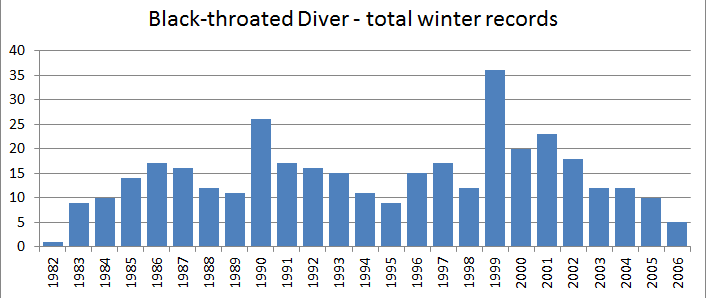Gavia arctica
Winter visitor and passage migrant
The Black –throated Diver has an Arctic breeding distribution, stretching from Siberia to Iceland extending as far south as Scotland. Those occurring on the eastern side of the Atlantic migrate to winter as far south as the Bay of Biscay and north-west Spain. Gavia arctica pacifica from North America and N E Siberia is currently considered as a separate species.
Previous commentators have assessed the Black – throated Diver in Pembrokeshire as a scarce winter visitor.
In winter they have been recorded in offshore waters all around the outer coast, once as far out as The Smalls, on 22nd January 1982. Because they can be difficult to detect and identify in the often choppy sea, they may be under recorded. Donovan and Rees (1994) suggested that perhaps a dozen were spread around the coastline each winter. The records for 1983 – 2003 show an average of six to seven detected each year, however nine were noted in four different years and 10 in 1997.
They have been noted within the Milford Haven / Cleddau Estuary waterway 14 times in eight different years, all single birds apart from two at Neyland on 28th December 1963.
Most were noted around Dale and the Gann but also once each at Angle Bay and Pembroke Dock, as far up the estuary as Landshipping on 31st December 1963 and at Lawrenny on 1st January 1997 which had reached Landshipping by February.
One which collided with the Cleddau Bridge during a storm in the late winter of 1996, was rescued by the Texaco Bird Hospital, rehabilitated and released at Lawrenny just before the end of the year. This bird probably accounts for the records at Lawrenny and Landshipping in January and February 1997 noted above.
The only record away from salt water was of two at Llys y fran Reservoir on 22nd February 1986.
An oiled bird was on the Teifi at Cilgerran on 19th & 20th March 1995 and two oiled birds were recovered during the Sea Empress oil spill of 1996.
 Total birds on record : 1982 – 2006
Total birds on record : 1982 – 2006
References
DICKENSON. H and HOWELLS. R. J. 1962. Divers in Wales, Nature in Wales 8.
DONOVAN. J and REES. G. 1994. Birds of Pembrokeshire, Dyfed Wildlife Trust.
LLOYD. B. 1929-1939 Diaries, National Museum of Wales.
LOCKLEY. R. M, INGRAM. C. S. and SALMON. H. M.1949. The birds of Pembrokeshire, West Wales Field Society.
MATHEW. M. 1894. The birds of Pembrokeshire and its islands, R. H. Porter.
 Wednesday, September 18, 2013 at 8:20AM
Wednesday, September 18, 2013 at 8:20AM 



